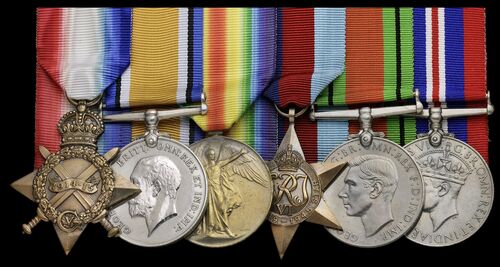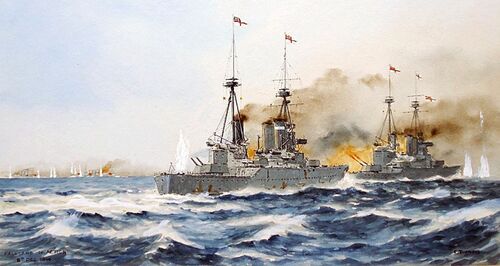Auction: 23001 - Orders, Decorations and Medals
Lot: 137
Six: Commander C. St. C. Ingham, Royal Navy, who served as a Gunnery Officer with Invincible at the Battles of Heligoland Bight and the Falklands Islands in 1914 and later with Canada at Jutland in 1916
Seeing Second World War service at Turtle, a Combined Operational Base Ingham's Midshipman's journal and wartime diaries have provided a valuable insight into the British Navy in wartime
1914-15 Star (Lieut. C. St. C. Ingham, R.N.); British War and Victory Medals (Lieut. C. St. C. Ingham. R.N.); 1939-45 Star; Defence and War Medals 1939-45, minor contact marks overall very fine (6)
Cameron St. Clair Ingham was born at Warley, Essex on 16 June 1891. Entering a Training Establishment on 15 May 1904 before being appointed Midshipman at Agamemnon on 15 January 1909. His first posting afloat was the newly launched battlecruiser Invincible, seeing further service with Ure, Bacchante and Dryad. Ingham was commissioned Acting Sub-Lieutenant with the town-class Light Cruiser Gloucester on 18 June 1912 and confirmed in the rank the next month on 15 July. Promoted Acting Lieutenant while serving with Sutlej from 1 July 1914 Ingham was posted to Invincible to act as a gunnery officer.
It was here that he took part in the first Battle of Heligoland Bight, as part of Beatty's Squadron. Invincible was bringing up the rear of the formation and paused to finish off the crippled Cöln. Despite firing a salvo of 18 shells they were unable to land a single hit upon their near helpless opponent. In the event Cöln was destroyed by fire from the Lion.
Despite her poor performance at the action Invincible was sent to the South Atlantic as the most powerful part of the British task force hunting the German East Asia Squadron. She joined the rest of the force at Abrolhos Rock and they made their way to Port Stanley, from there to conduct the search for their enemy. Remarkably, having been delayed by Invincible, they found the German's had come to them in an attempt to refuel at the Naval Station on the Island. Heavy fire from the guard ship Canopus gave Von Spee pause and Admiral Sturdee - his pennant raised on Invincible - order the British to attack.
Bravely Von Spee led his armoured cruisers to engage the British Battlecruisers, realising that he could not outrun them but hoping a stand up fight would allow the Light Cruisers time to escape. Scharnhorst and Gneisenau managed to score hits on Invincible but failed to cause any lasting damage. By contrast the battlecruiser's guns tore into them, Ingham - whose role granted him a fine view - noted a bizarre incident when a full-rigged French sailing ship passed between the duelling behemoths. Apparently they had been without a wireless radio for months and were not aware that the war had started.
Scharnhorst was soon listing in the face of the barrage and went down, taking Von Spee with her. Gneisenau kept fighting until she ran out of ammunition, Invincible kept up her fire and the cruiser sank soon afterwards. After the battle Ingham was to prove lucky, he was posted away from Invincible in June 1915 and thus avoided her tragic fate at Jutland. Instead he joined the ships company of Canada to serve again as a gunnery officer in her foremost 14-inch turret.
Canada was part of the 4th Battle Squadron and as such sallied with Admiral Jellicoe to the aid of the Battlecruiser Fleet at the Battle of Jutland. She was 12th of 24 in the British line of battle and fired 42 shells from her main armament. Perhaps the best description of her role comes from the citation for her Captain's C.B. '... by effective gunfire of his command materially assisted in forcing the enemy to retire.' Ingham remained with the ship for almost the entire war, leaving for Hyacinth on 14 September 1918.
After the end of hostilities he joined the company of another Jutland survivor, the town-class cruiser Birmingham. Later posted to the battleship Ramillies he joined her as part of the International Fleet at the Bosporus as part of General Harrington's mission. Later being promoted Lieutenant-Command aboard her on 15 January 1923. Going ashore on 24 August 1923 Ingham was appointed Intelligence Officer South China going on to command the gunboat Moorhen on the Si Kiang River from 4 February 1927. In this capacity he witnessed the disturbances in China at that time.
Joining the reserve on 10 June 1932 he was recalled to service at H.M.S. Cardiff. Posted to the depot ship Marshall Soult on 10 July 1940, Ingham was promoted Commander here on 21 August of that year. In this role he served ashore throughout the Second World War with a notable stint as commander of H.M.S. Turtle, the combined operations training base at Poole. Ingham retired at his own request on 12 September 1945, he died at Bournemouth in 1969; sold together with copied research comprising census data, service records and information on H.M.S. Moorhen.
Subject to 20% VAT on Buyer’s Premium. For more information please view Terms and Conditions for Buyers.
Sold for
£220
Starting price
£110







